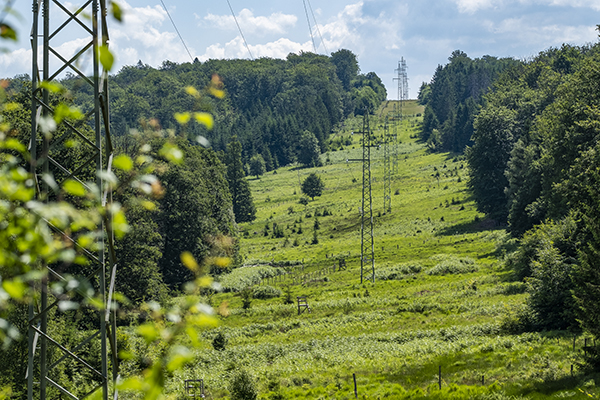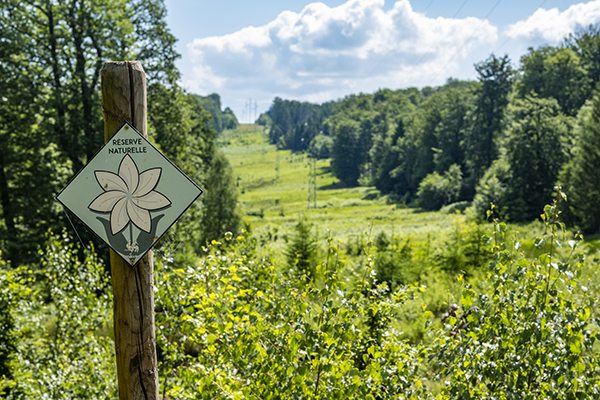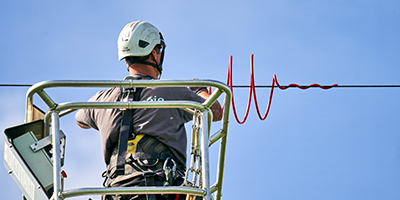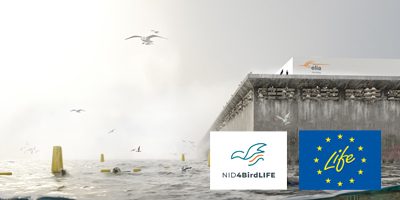Preserve and strengthen ecosystems and biodiversity
The development and maintenance of our grid impacts the surrounding landscape, fauna and flora. It is however possible to combine the transmission of electricity with biodiversity objectives. Elia has initiated several actions that are proof of this, within the framework of our sustainability program ActNow.

I. Rehabilitation of natural habitats under lines
Ecological corridors
We create ecological corridors under our overhead lines that go through forest areas. That means we implement measures that benefit biodiversity by creating natural habitats in forests (like peatlands, forest edge shrubs, grazed pastureland, ponds, etc.). We then minimize our interventions in these areas so that these habitats can be maintained in the long term, in contrast with the classical way of maintaining the corridors by clear-cutting all vegetation under the line.
This method started in 2011 with a 7-year EU-funded LIFE project (“LIFE ELIA-RTE") together with the French TSO. Further information on this project can be found on http://www.life-elia.eu/ and in this press release. Since then, Elia Transmission Belgium SA/NV has been a front-runner in integrated vegetation management.
In 2018, we decided to continue this type of vegetation management without receiving any subsidies, by adding each year more ecological corridors under our lines. It is now a clear objective within our ActNow sustainability program. By 2030, our ambition at a group level (both for Elia in Belgium and for 50 Hertz in Germany) is to manage 90% of all our forest corridors in a way that supports biodiversity.
We have also run several communication campaigns aimed at raising various target groups' awareness of the importance of taking biodiversity into account when managing vegetation. Training modules were set up, leaflets were published, and information panels and viewing platforms were installed around our lines.


Nature Management Plan (Natuurbeheerplan)
In Flanders, Elia is preparing a Nature Management Plan (Natuurbeheerplan) for the ecological corridors. This is done in collaboration with the regional Agency for Nature and Forest. A Nature Management Plan is an official document describing the type of habitats we aim for with the ecological corridors and the type of vegetation management we will undertake in the next 24 years to achieve this goal. This formalises the ecological goals in the Elia-managed forest corridors in the Flanders region. Starting in 2024, our sites with ecological corridors will be integrated into this Nature Management Plan.
II. Bird protection
Bird collisions with overhead lines are a major effect of our lines. We have therefore developed a specific policy for the protection of birds. The main objective is to reduce the number of birds that collide with our overhead lines.
Bird protection against collisions

With the help of the largest Belgian environmental organizations (Natuurpunt and Natagora), Elia has identified the collision risk of each line of the Belgian grid. Thanks to this risk atlas, which is regularly updated, we know which sections of our grid pose the greatest danger to birds.
These sections are gradually being fitted with bird markers, which reduce the probability of bird collisions by making them more visible to birds. If a project is due to take place on these sections, markers will be installed immediately during the project.
We want to have bird markers installed on all the most critical lines for birds by 2030, that means on 200 km of our overhead lines in Belgium..

On top of the already ongoing placement of bird markers, Elia takes part in an EU-funded LIFE project, together with Natuurpunt, Natagora and a consortium composed by a dozen of organizations from France, Portugal and Germany.
The goal of the SafeLines4Birds project is to reduce bird mortality caused by power lines
.
The project started in 2023 and will last until 2028. This project will look into innovative ways to prevent collisions and many concrete actions will be taken against collisions and electrocution. Dissemination of the knowledge about bird protection is also an important part of the LIFE project.
NID4BirdLIFE

The NID4BirdLIFE project is a 6.5-year initiative co-financed by the LIFE Programme, the European Union's funding instrument for environment and climate action. The project aims to address the critical decline of the black-legged kittiwake (Rissa tridactyla) population by creating a durable breeding stronghold on the Princess Elisabeth Energy Island. This will be achieved through the integration of Nature-Inclusive Design (NID) elements into the island's wave walls.
III. Biodiversity actions in substations
More biodiversity in our substations
In and around our substations, we often own parcels of land where infrastructures are not (yet) present. In these places and around existing infrastructure, we implement green areas to encourage biodiversity and reduce the negative impacts of our assets on the ecosystem. For example, we sow flower meadows, plant wild orchards and green hedges, install insect boxes, dig ponds, ...
The Mercator substation in the municipality of Kruibeke has become the home of a rare species of salamander: the great crested newt. In late 2004, we collaborated with one of our members of staff who volunteers at Natuurpunt, build two ponds in order to rehabilitate this rare species. Now, almost 20 year later, a population of great crested newts has taken up residence under the Mercator substation. Flushed with this success, we installed four more ponds with the help of the environmental association Regionaal Landschap Schelde-Durme.
Indigenous hedges are planted each year around our high-voltage substations to both help our facilities to merge into the surrounding landscape and provide a habitat for local fauna. We also use thorny shrubs to deter intruders. Due to more stringent regulations concerning the security of substations, these hedges are now being combined with low growing meadow stripes along fences.
Ban on pesticide
Since 2022, we have banned the use of all herbicides from all our sites. Vegetation management in our substations is done mechanically. Under our electrical equipment, instead of gravel, the ground surface turns gradually into a green cover.
Invasive alien species control
Invasive alien species are an important threat for biodiversity. In 2023, a new strategy was developed and validated by Elia to limit the spread of invasive species in our substations. By the end of 2027, all substation sites will be surveyed to detect which invasive plants are present. Contractors who maintain our substations are trained to undertake differentiated management when encountering these plants.
IV. Increase impact of nature protection activities related to grid development
Grid planning
One of our biggest challenges is to maintain and expand the grid while ensuring a sustainable approach to environmental impact. To that end, we develop our grid infrastructure according to the following principles of always considering first a grid optimization, then a strengthening of the grid before any further expansion of the grid.
In the geographical areas where we operate as TSO, an environmental impact assessment (EIA) makes part of the permitting requests and is conducted in the early stages of infrastructure projects. It also allows the systematic identification, prediction and analysis of the potential impacts and threats on the physical environment and biodiversity, as well as social, cultural, and health impacts during both the construction and operation phases.
Landscape integration and biodiversity reinforcement
When planning projects, not only are economic efficiency, the concerns of local residents and the technology taken into account during the approval procedures, but so are the protection of flora and fauna. In the run-up to such procedures, environmental impact assessments or town-planning permissions application are carried out to minimize nature conservation conflicts at an early stage. A corridor is then identified for the exact route of the electrical line and defined in a subsequent step.
At the same time, protection and compensation measures are identified. All these investigations are carried out together with external environmental planners, routing experts and, if necessary, other science and nature conservation experts. Nature requirements are included in the contractual requirements of the infrastructure projects. To discover these measures, go see the following page.
It is important for Elia to play a societal role and thus prioritize the interests of the community as well as the sustainability. We strive to build partnerships in order to fund projects that address these concerns. To learn more, please visit our partnerships page.
V. Project management in protected areas
The legal framework regarding activities in nature protected areas is very strict in Belgium.
For overhead lines or cables projects in Natura 2000 areas, an appropriate impact assessment has to be conducted and added as an appendix to the environmental impact assessment study.
For major infrastructure projects, an expert is appointed to implement environmental recommendations during the construction phase.
In specific cases, the development of project/worksite monitoring has been carried out with particular attention paid to environmental protection.
VI. Offshore
Regarding our offshore activities, we align the development of our infrastructure with the respect of the marine environment.
Based on input from a range of experts, the company has developed seven tangible measures to improve biodiversity around the Princess Elisabeth Island. Nature Inclusive Design (NID) is taken into account for this project from the start. For example, ledges attached to the outer storm walls will provide somewhere for the black-legged kittiwake, a vulnerable bird species, to rest and breed. Below the waterline, several measures will be combined to create a diverse and rich artificial reef. The measures were selected based on their technical feasibility and expected positive impact. Through this initiative, Elia is striving to become a pioneer in the sustainable construction and operation of offshore infrastructure. A scientific monitoring programme will be rolled out to follow up on the results of this unique project and make adjustments if necessary.
We also participate in the Offshore Coalition for Energy and Nature (OCEaN). The ongoing biodiversity and climate crisis have prompted various non-governmental organisations (NGOs), wind industry actors and transmission system operators (TSOs) to join forces and cooperate in a coalition to accelerate the deployment of offshore wind energy and grid infrastructure while ensuring alignment with nature protection and healthy marine ecosystems. Today, 32 organisations from across Europe are committed to working together to achieve these goals.

